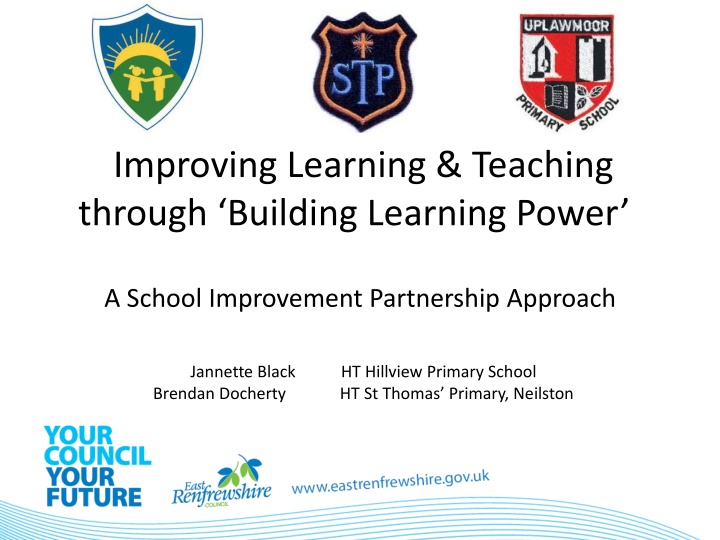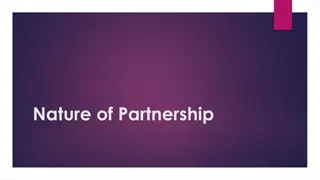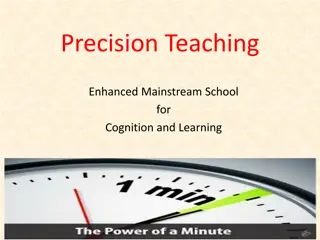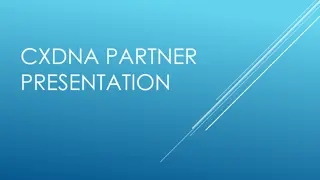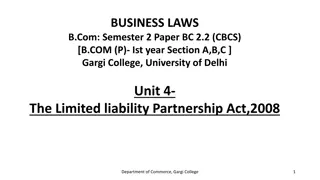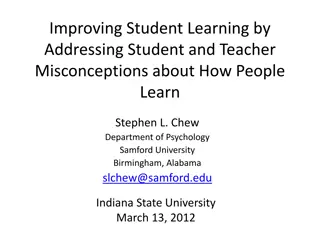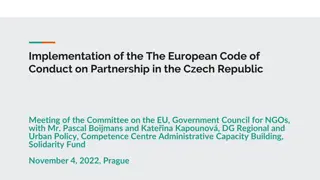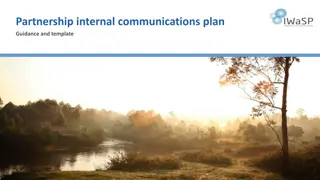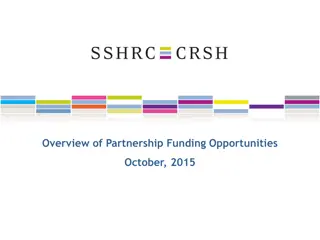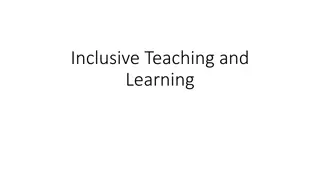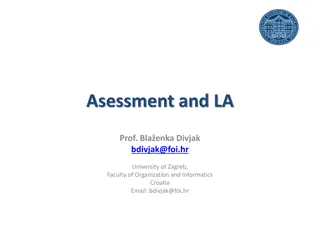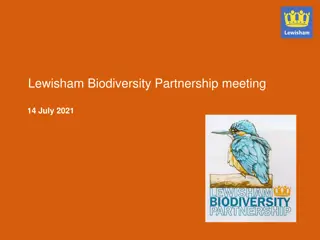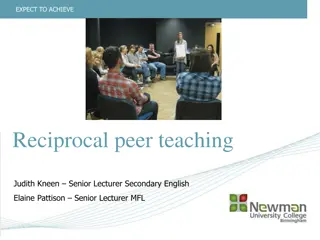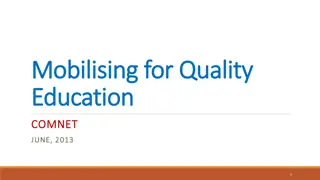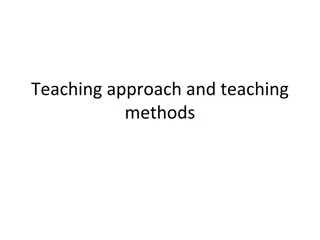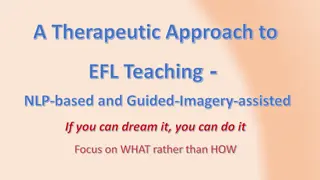Improving Learning and Teaching through Partnership Approach
This seminar explores how schools in ERC have collaborated using the School Improvement Partnership model to implement Building Learning Power. Topics include Self Evaluation, National Pupil Equity Funding, and the impact on pupil attainment. Strategies focus on enhancing teacher professionalism and learning quality to raise standards for all learners.
Download Presentation

Please find below an Image/Link to download the presentation.
The content on the website is provided AS IS for your information and personal use only. It may not be sold, licensed, or shared on other websites without obtaining consent from the author.If you encounter any issues during the download, it is possible that the publisher has removed the file from their server.
You are allowed to download the files provided on this website for personal or commercial use, subject to the condition that they are used lawfully. All files are the property of their respective owners.
The content on the website is provided AS IS for your information and personal use only. It may not be sold, licensed, or shared on other websites without obtaining consent from the author.
E N D
Presentation Transcript
Improving Learning & Teaching through Building Learning Power A School Improvement Partnership Approach Jannette Black HT Hillview Primary School Brendan Docherty HT St Thomas Primary, Neilston
Seminar objectives This seminar will examine how a group of schools in ERC have collaborated using the School Improvement Partnership model to implement Building Learning Power
Self Evaluation National Pupil Equity Funding National Improvement Framework How Good is our School? 4 Local Authority HT Seminar Professional Enquiry School Improvement Partnerships Cluster and School Level Engagement of all staff Target groups of pupils Impact for pupils on attainment and achievement
PEF Funding and NIF Priorities We want to continue to improve the professionalism of our teachers and the quality and impact of their professional learning Ensuring the highest professional standards for all teachers in Scotland will help to ensure the highest standards and expectations for all children and young people. National Improvement Framework
Targeted Groups Existing Data: o Lowest 20% o SIMD 1-4 o Standardised test scores o Gender differences
BLP Programme Introduction to programme activity based Morning All staff Afternoon Session for SLT INSET Perseverance/Becoming Unstuck/Introducing Challenge/Dealing with Distractions Online quiz related to practice and classroom culture Reading Suggestions for implementation ONLINE Professional Dialogue Professional Reflection (on previous months action plan) Creation of Personal Action Plan Whole School Implementation TLC
Target Groups of Pupils SIPP St Thomas and Hillview previous SIPP Uplawmoor, St Thomas and Hillview similar groups of pupils Interventions: Building Learning Power Short term study of change
School Improvement Partnership Approach Partnership working The use of action research and evidence The creation of leadership opportunities A commitment to reciprocity The development of arrangements to support long-term collaboration Explicit links to strategic improvement planning Diverse range of partners
School Improvement Partnership Approach Key features of effective school improvement partnerships: Targeting achievement Understanding context Using evidence Teachers leading change Learning from similarity and diversity. Moving practice and expertise around the partnership. Building relationships and networks
School Improvement Partnership Approach
Phase One: Performance Information Analysis and Outcome Focussed Planning Step One: Analyse pupil performance information Target Group: Lowest performing 20% within P7 class Number of Pupils: 4 pupils per school for analysis Detail the rationale for selection Lowest performing 20% SIMD 1-4 ST scores 78-89 for Reading Children who do not identify themselves as readers or interested in reading
Step Two: Identify Research question SMART outcomes for the target group Main Research Question Can a coherent approach to implementing Building Learning Power improve literacy attainment? Does this programme: a) Develop resilience, resourcefulness, reflectiveness and reciprocity in pupils during literacy lessons? b) Improve Literacy skills in a group of identified children?
Step Two: Identify SMART outcomes for the target group The children will be able to: Use [Commercial programme] Language to help them when they are learning Demonstrate resilience when engaging with a range of texts Demonstrate resourcefulness in literacy lessons Demonstrate reflectiveness within literacy lessons Ability to work independently and with others in a group. Improve reading comprehension scores
Phase Two: Exploring and Understanding the Target Groups Performance Step One: Explore the strengths of and pressures on your target group Strengths/positive factors: Very good pupil/ teacher relationships Decoding skills of pupils Small class and extra teacher support throughout the week
Phase Two: Exploring and Understanding the Target Groups Performance Step One: Explore the strengths of and pressures on your target group Pressures/negative factors: Lack of confidence in reading Lack of engagement Low levels of resilience Lack independence in terms of selecting strategies Poor comprehension scores
Step Two: Evaluating the significance of the factors identified Confirmed strengths/positive factors: Reading running record Pupil questionnaire on their perceptions of reading and themselves as readers Pre and post reading assessment Parental questionnaire
Step Two: Evaluating the significance of the factors identified Confirmed pressures/negative factors: Resistance to change New vocabulary to mindset New teaching approaches Assessment data
Lesson Study: Why do it? To enhance professional knowledge An emphasis on sharing ideas and knowledge School as a professional learning community .
Lesson Study: Key stages 1. Setting goals 2. Planning the lesson (see handout for structure) 3. Teaching and observing 4. Debriefing sharing evidence of student learning. 5. Revising 6. Reflection and sharing
Measuring Impact so far Leuven scale Neale analysis SNSA ER Standardised tests
Measuring Impact and Next Steps Pupil surveys to gauge impact Use of [Commercial Programme] language across curricular areas Increase in pupils leading learning across the school Pupils Introduce parents to [Commercial Programme] approach and language Invite parents to Learning Assemblies on [Commercial Programme] Run workshops on [Commercial Programme] Parent evaluations Parents Continue with Online and TLC sessions (3 year cycle) Organise inset evaluation session for staff for 6 schools (Feb 2019) Evaluation of Staff surveys on change in practice and classroom culture Rollout of [Commercial Programme] to other schools within Clusters Staff
Thank you for listening! Any questions?
